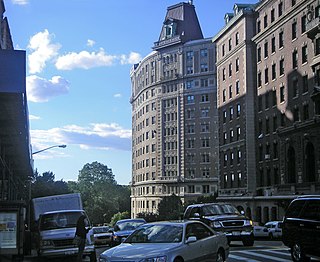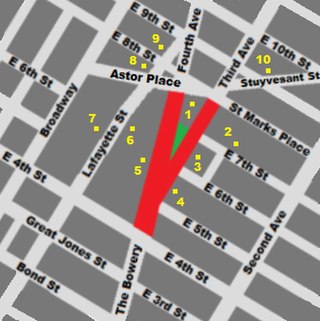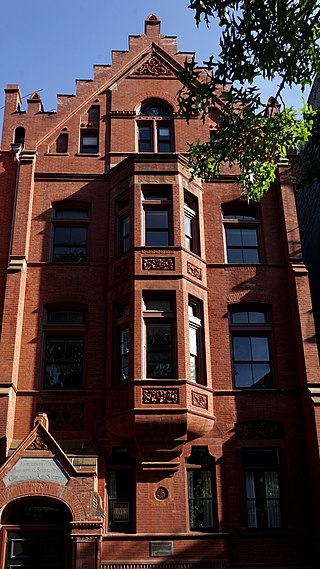
School of the Future is a public secondary school located at 127 East 22nd Street at Lexington Avenue, in the Gramercy Park neighborhood of the borough of Manhattan in New York City. It serves grades 6 through 12 as a part of the New York City Department of Education, and accepts students from around the entire city. School of the Future, a small school, was founded in 1990 with funding by Apple Inc. with an admissions process dependent on student application.

116th Street runs from Riverside Drive, overlooking the Hudson River, to the East River, through the New York City borough of Manhattan. It traverses the neighborhoods of Morningside Heights, Harlem, and Spanish Harlem; the street is interrupted between Morningside Heights and Harlem by Morningside Park.

Cooper Square is a junction of streets in Lower Manhattan in New York City located at the confluence of the neighborhoods of Bowery to the south, NoHo to the west and southwest, Greenwich Village to the west and northwest, the East Village to the north and east, and the Lower East Side to the southeast.

Clinton and Russell was a well-known architectural firm founded in 1894 in New York City, United States. The firm was responsible for several New York City buildings, including some in Lower Manhattan.

29 East 32nd Street is a building in Manhattan, New York City. Built in 1889 and designed by Charles W. Romeyn in the Richardsonian Romanesque style, it originally housed the Grolier Club. It is now called the Madison and became a New York City designated landmark in 1970.

The Samuel J. Tilden House is a historic townhouse pair at 14-15 Gramercy Park South in Manhattan, New York City. Built in 1845, it was the home of Samuel J. Tilden (1814–1886), former governor of New York, a fierce opponent of the Tweed Ring and Tammany Hall, and the losing presidential candidate in the disputed 1876 election. Tilden lived in the brownstone from 1860 until his death in 1886. From 1881 to 1884, Calvert Vaux combined it with the row house next door, also built in 1845, to make the building that now stands, which has been described as "the height of Victorian Gothic in residential architecture" with Italian Renaissance style elements. Since 1906 it has been the headquarters of the National Arts Club, a private arts club.

The John Street United Methodist Church – also known as Old John Street Methodist Episcopal Church – located at 44 John Street between Nassau and William Streets in the Financial District of Manhattan, New York City was built in 1841 in the Georgian style, with the design attributed to William Hurry and/or Philip Embury. The congregation is the oldest Methodist congregation in North America, founded on October 12, 1766 as the Wesleyan Society in America.

Cast Iron House at the corner of Franklin Street and Broadway in the Tribeca neighborhood of Manhattan, New York City, formerly known as the James White Building, was built in 1881–82 and was designed by W. Wheeler Smith in the Italianate style. It features a cast-iron facade, and is a good example of late cast-iron architecture. The building was renovated by architect Joseph Pell Lombardi in 2000, and a restoration of the facade began in 2009. The building once housed the offices of Scientific American from 1884 to 1915, but it was primarily used in connection with the textile trade.

Firehouse, Engine Company 31 is a historic fire station located at 87 Lafayette Street between Walker and White Streets in the Civic Center neighborhood of Manhattan, New York City. It was built in 1895 and designed by architects Napoleon LeBrun & Sons, who styled it after an early-16th-century chateau in the Loire Valley of France.

161 West 93rd Street is a building on 93rd Street in Manhattan that was once the home of the Nippon Club, a gentlemen's club for Japanese Americans and Japanese nationals.

95th Street runs from Riverside Drive, overlooking the Hudson River, to the East River, through the New York City borough of Manhattan. It traverses the neighborhoods of Upper West Side, Upper East Side, Carnegie Hill, and Yorkville; the street is interrupted by Central Park.

Elliott Lynch, AIA, was an American architect active in the late 19th and early 20th centuries in New York City. His office was located at 347 Fifth Avenue in Manhattan. Many of the buildings he designed remain standing.

The Fourteenth Ward Industrial School is located at 256-258 Mott Street between Prince and Houston Streets in the Nolita neighborhood of Manhattan, New York City. It was built for the Children's Aid Society in 1888–89, with funds provided by John Jacob Astor III, and was designed by the firm of Vaux & Radford in the Victorian Gothic style. The Society built a number of schools for indigent children at the time. It was later known as the Astor Memorial School.

The former Second Church of Christ, Scientist is a historic Christian Science church building located at Central Park West and West 68th Street on the Upper West Side of Manhattan, New York City, within the Central Park West Historic District. The Beaux-Arts building was designed by architect Frederick R. Comstock and constructed in 1899–1901. The building was restored beginning in 2005 by Sydness Architects which planned to clean the facade, reinforce the stained-glass windows, and waterproof the copper dome and illuminate the skylight.

The Daniel LeRoy House is located at 20 St. Marks Place in the East Village neighborhood of Manhattan in New York City. The Greek Revival building was built in 1832 as part of a development by Thomas E. Davis of 3½-story brick houses which spanned both sides of the street. The Daniel LeRoy house is one of the three surviving houses of this development, the other two being 25 St. Marks Place and the Hamilton-Holly House at 4 St. Marks Place. It has a marble entrance ornamented with vermiculated blocks. LeRoy was an in-law of Peter Stuyvesant, and a South Street merchant, who lived in the house with his wife Elizabeth Fish, of the eminent Fish family.

203 East 29th Street is a historic house and carriage house located between Second and Third Avenues in the Kips Bay neighborhood of Manhattan, New York City, one of a small number of wooden houses that remain on Manhattan Island. The year the house was built is uncertain, having been variously dated from as early as around 1790 to as late as 1870.

The United States Post Office Madison Square Station is a historic post office building located at 149 East 23rd Street between Lexington Avenue and Third Avenue on the East Side of Manhattan, New York City. In spite of the building's name, it is not located on Madison Square but about three blocks east along 23rd Street. The building runs through the block to East 24th Street, where there are loading docks and another much smaller and less formal public entrance.

The Church of the Epiphany is a parish church of the Roman Catholic Archdiocese of New York, located at 373 Second Avenue at the corner of East 22nd Street, in the Gramercy Park neighborhood of Manhattan in New York City. It operates a co-educational PreK–8 Catholic school and Religious Education program.

The Maritime Hotel is a luxury boutique hotel located at 363 West 16th Street at Ninth Avenue in the Chelsea neighborhood of Manhattan, New York City, close to the Meatpacking District. It has 121 rooms and 5 suites, all decorated in a nautical theme, in line with the building's maritime history, and the porthole-inspired facade.

Thomas F. Houghton was an Irish-born American architect who was for many years the chief draftsman for the firm of Patrick Keely.























